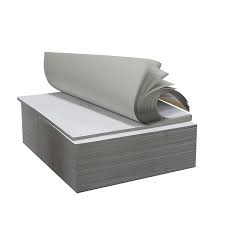- Home
- Duplex Board Production Process for Wholesale Manufacturing Solutions
Nov . 10, 2024 06:09 Back to list
Duplex Board Production Process for Wholesale Manufacturing Solutions
Understanding the Wholesale Duplex Board Manufacturing Process
Duplex board, a popular choice in the packaging industry, is made from recycled paper and is known for its smooth surface and exceptional printing quality. The manufacturing of duplex board involves a series of intricate processes that ensure its durability and functionality. This article explores the wholesale duplex board manufacturing process, shedding light on the key stages involved.
1. Raw Material Collection
The first step in manufacturing duplex board is the collection of raw materials. The primary component of duplex board is recycled paper, which includes waste paper, cardboard, and other paper products. The use of recycled materials not only contributes to sustainability but also helps in reducing the cost of production. Suppliers gather these materials from various sources, such as recycling plants and paper mills.
2. Pulping Process
Once the raw materials are collected, they undergo a pulping process. This is a critical stage where the paper is shredded into smaller pieces and mixed with water and chemicals to break down the cellulose fibers. The mixture is then subjected to mechanical and chemical treatments to produce pulp. The quality of the pulp significantly influences the final product's strength and smoothness.
There are two methods of pulping mechanical pulping and chemical pulping. Mechanical pulping uses physical energy to separate the fibers, while chemical pulping involves the use of chemicals to dissolve lignin and other components. For duplex board production, a combination of both methods may be used to achieve the desired properties.
3. Washing and Bleaching
After pulping, the resulting slurry is washed to remove impurities and excess chemicals. This process is vital to ensure the purity of the pulp, which directly affects the whiteness and brightness of the duplex board.
Next, the pulp may be bleached to enhance its brightness and whiteness. Bleaching agents are used carefully to avoid damaging the fibers. The degree of bleaching can vary depending on the desired end product, with some manufacturers opting for unbleached duplex board to preserve its natural color and sustainability.
wholesale duplex board manufacturing process

4. Formation and Pressing
Once the pulp is prepared, it is diluted with water and formed into a sheet on a large mesh belt. The water drains away, and the fiber binds together to create a continuous sheet of wet pulp. This sheet is then pressed to remove additional water and increase its density.
The pressing process involves several rollers that apply pressure to the sheet, enhancing its thickness and providing stability. This stage is crucial in determining the final texture and strength of the duplex board.
5. Drying Process
After pressing, the sheets are passed through a drying section where hot air is used to remove the remaining moisture. The drying process is carefully controlled to prevent any damage to the fibers, which could compromise the board's strength. Once dried, the duplex board is robust, ready for cutting and further processing.
6. Coating and Finishing
To improve the printability and overall appearance of the duplex board, a coating is often applied. This can be a clay-based coating or a polymer coating, depending on the desired finish. Coating not only enhances the surface quality but also increases the board's resistance to moisture and other environmental factors.
Following the coating process, the duplex board may undergo further treatments such as calendaring, which smooths the surface for better printing quality. The finished product is then cut into sheets of various sizes, packaged, and prepared for wholesale distribution.
Conclusion
The manufacturing process of wholesale duplex board is a meticulous and complex operation that ensures the production of a high-quality product. From raw material collection to pulping, pressing, drying, coating, and finishing, each step plays a crucial role in determining the board's strength, printability, and overall performance. As the demand for sustainable and durable packaging solutions continues to grow, understanding this process becomes increasingly important for businesses in the packaging industry. By utilizing recycled materials and advanced manufacturing techniques, duplex board manufacturers can meet the needs of their customers while contributing to environmental sustainability.
Latest news
-
High-Quality Bathroom Cabinet Contact Paper – Durable & Stylish Leading Suppliers, Exporters, Manufacturers
NewsJul.08,2025
-
Premium Wood Contact Paper for Desk – Reliable Suppliers & Exporters
NewsJul.08,2025
-
Premium Contact Paper for Table Top – Durable & Stylish Surface Solution from Leading Manufacturer
NewsJul.07,2025
-
Duplex Board with Grey Back - Reliable Supplier & Competitive Price Manufacturer & Exporter
NewsJul.07,2025
-
Premium White Contact Paper on Cabinets – Trusted Exporters & Suppliers
NewsJul.06,2025
-
High-Quality Duplex Board Packaging for Food Reliable Manufacturer & Supplier
NewsJul.06,2025

